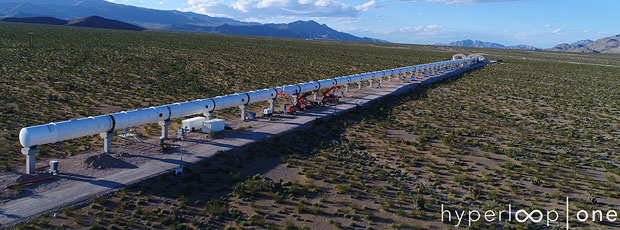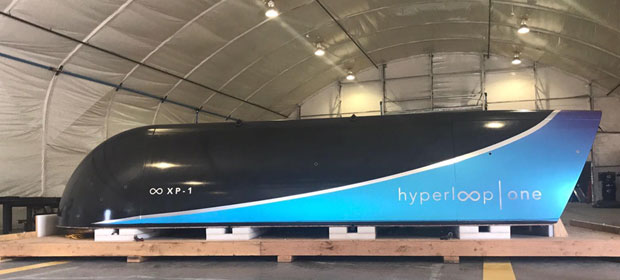Hyperloop One on Wednesday announced that it had conducted a successful first test of a specially designed vehicle to travel in a vacuum environment. In the test, which took place earlier this year, the company achieved controlled propulsion and levitation of a Hyperloop One vehicle at 70 mph on a 315-foot test track in the Nevada desert. The test vehicle reached nearly 2Gs of acceleration during its brief 5.3 second test run on the specially built track.
A comparison has been drawn between the Hyperloop accomplishment and the Wright Brothers’ first test flight in December 1903. Just as brief as the Hyperloop One test, it is recognized as one of the key events in the evolution of manned flight. However, it took several years before airplane technology was refined and developed enough to move beyond the test stage.
Hyperloop One’s vehicle test also represents a small step toward a potential giant leap to levitated transportation. The company was quick to note that history wasn’t made by the event itself, but by the people responsible for making it happen. The startup had the support of nearly 200 engineers, machinists, welders and fabricators, who all worked together to reach a common goal.
The next step will be to conduct a wider test of the system at the company’s DevLoop site, which utilizes almost 1,000 feet of the linear motor in a 1,640 foot long tube.

The DevLoop is capable of reducing the air pressure to the equivalent of 200,000 feet above sea level, which could allow the Hyperloop One to travel at speeds of 250 mph.
The newly unveiled XP-1 pod (pictured above), which will be tested at the DevLoop facility. The XP-1 pod is constructed with lightweight carbon fiber and aluminum around the levitating chassis.
Musk Concept
The Hyperloop transportation concept owes much to the work of Tesla and SpaceX founder Elon Musk, who in a 2013 white paper described his vision of a high-speed, mass-transit system. Musk proposed utilizing pods that would coast on an a cushion of air. He claimed that such a system would be safer, faster and cheaper than existing methods of transportation.
However, Musk is not involved with Hyperloop One, and the company’s founders have been quick to note that they made substantive technical modifications to Musk’s concept. In addition, the company has opted not to pursue a San Francisco to Los Angeles corridor route, which Musk had favored, for the first Hyperloop system.
Hyperloop One currently is developing both passenger and cargo systems for potential use in the United States, parts of Europe and the Middle East. The company’s goal is to have a fully operational line running by 2020, but it is unclear if its Kitty Hawk moment truly marks the beginning of its road to that destination.
“The Wright Brothers’ ‘Kitty Hawk’ was a test of concept, not a practical vehicle — and at this phase, so is Hyperloop,” said Rob Enderle, principal analyst at the Enderle Group.
“Before Kitty Hawk, the idea of heavier-than-air flying was debated. After, it was whether it could be made practical — not whether it would work,” he told TechNewsWorld.
“We now know it works,” Enderle said of Hyperloop’s tech. “We don’t yet know if it is practical — though we are arguably closer than we were with that initial plane, which didn’t look practical at all.”
The Jump to Hyperspeed
The Hyperloop One test could be good for getting news coverage and convincing people that the technology is possible, but even if it is not quite as experimental as the Wright Brothers’ first plane, its practicality is far from being established.
“The test of this technology is really interesting, but it won’t be enough to usher in a new transportation age,” cautioned Roger Kay, principal analyst at Recon Analytics.
The probability that it ever will replace existing forms of transportation is relatively low, Enderle suggested.
“MagLev was far more practical out of the box,” he pointed out, “but it never achieved mass adoption.”
The problem, in part, is that it would require a massive investment in the technology.
“This test was done to get funding, but when you think of the investors — there aren’t any,” Kay told TechNewsWorld. “Even with funding, they would need to get concessions from local government, and then the costs go up.”
Use Cases
Even if the funding hurdle could be cleared, there is the issue of whether creating new infrastructure would be practical, given what already moves via trucks or existing rail lines.
“Hyperloop isn’t great for freight. It requires a vacuum, which creates both safety and cost issues. While faster, cheaper aircraft already has broader applications,” Enderle said.
On a positive note, “it is an intriguing technology that holds potential for ferrying passengers over long distances,” suggested Jim McGregor, principal analyst at Tirias Research.
“However, this is the combination of a new technology and infrastructure project, which means astronomical costs and unimaginable regulatory red tape,” he told TechNewsWorld. “I doubt that anyone, including those in the company, can accurately predict the final cost or schedule of a single project. They just have to expect cost and schedule overruns.”
Addressing the Vulnerabilities
Even smaller problems — such as if a pod were to get trapped due to mechanical failure — could become serious issues that would require backup plans.
“This is no different than other mass transit options like subways and high-speed trains,” said McGregor. “In the end, the cost must justify the investment relative to other options, and only time will tell if this can be achieved.
Perhaps the thorniest issue that Hyperloop One needs to overcome is how to deal with geopolitical ideologies and protect its system from a terrorist attack.
An elevated tube could make a very inviting target for a radical group, and it might not be too difficult even for a lone actor to do considerable damage to a costly piece of equipment.
Of course, “all forms of transportation are exposed to attacks like this, so I don’t see this necessarily as a deal breaker, particularly because it would likely go in with far better monitoring and have far fewer problems related to aging tracks initially,” Enderle said.
Yet a high-profile crash resulting either from a terrorist attack or an accident could derail this project.
“As the Hindenburg showcased, one strategic catastrophic accident could kill it,” said Enderle. “It is too early to say it will fail, but the path to success is long, and [Hyperloop One] faces a number of critical technical and competitive challenges.”






















































